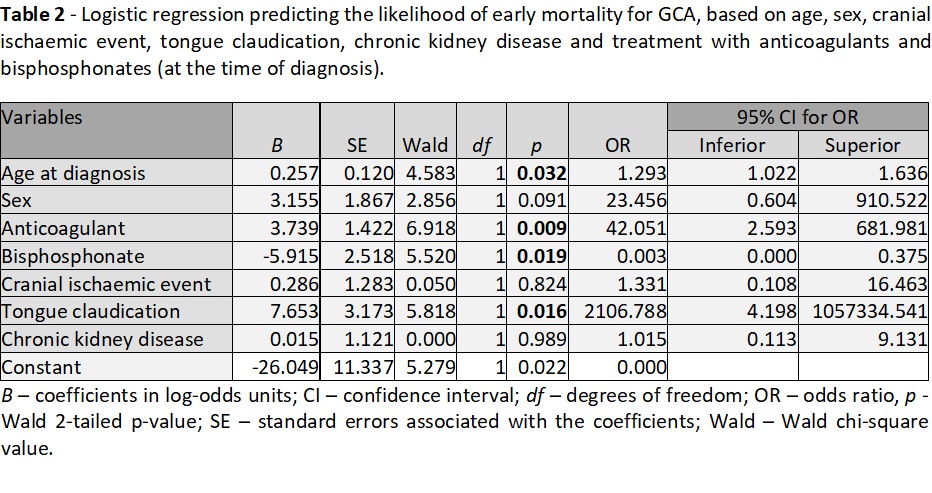Session Information
Date: Monday, November 9, 2020
Title: Vasculitis – Non-ANCA-Associated & Related Disorders Poster II
Session Type: Poster Session D
Session Time: 9:00AM-11:00AM
Background/Purpose: Giant cell arteritis (GCA) is the most common form of primary systemic vasculitis, typically affecting patients aged > 50 years. If left untreated, GCA can lead to permanent visual loss and other ischaemic complications. During the first two years of diagnosis, mortality is significantly higher in GCA than in the general population, with a significant contribution of infections to mortality in the first year of treatment. Identifying patients with a higher risk of mortality at the time of diagnosis could be crucial for prevention and tailored treatment; however, independent predictors of early mortality have never been reported in the literature.
Methods: Bicentric observational study using data from the Portuguese Register of Rheumatic Diseases (Reuma.pt). Patients with biopsy- or ultrasound-proven GCA were included. Early mortality was defined as death occurring in the first two years after diagnosis. Univariate analysis was performed using Chi-Square, Fischer’s Exact Test and Mann-Whitney Test, as appropriate. Multivariate analysis was
performed using binary logistic regression modelling. The linearity of the continuous variables with respect to the logit of the dependent variable was assessed via the Box-Tidwell procedure.
Results: The study included 133 patients with 85 (66.4%) females and a median age at diagnosis of 75.0 (interquartile range [IQR] 12.0) years. Fourteen (10.5%) deaths occurred during the first two years after diagnosis. Early mortality was significantly associated with: (i) cranial ischaemic event, anterior ischaemic optic neuropathy, permanent loss of vision and tongue claudication at disease presentation; (ii) older age, atrial fibrillation, chronic kidney disease, creatinine level and treatment with bisphosphonates at diagnosis; and (iii) treatment with anticoagulants before disease onset (Table 1).
The multivariate analysis included 124 patients (5 patients had missing information, 4 patients were outliers) with 81 (65.3%) females, a median age at diagnosis of 75.0 (IQR 12.0) years, and 10 (8.1%) deaths in the first two years of diagnosis. The logistic regression model was statistically significant, χ2 (7) = 42.0, p< 0.001. The model explained 66.9% (Nagelkerke R2) of the variance in early mortality and correctly classified 96.0% of all cases. Older age at diagnosis (OR 1.3/year, 95%CI: 1.0-1.6, p=0.032), tongue claudication at disease presentation (OR 2106.8, 95%CI: 4.2-1057334.5, p=0.016), previous treatment with anticoagulants (OR 42.1, 95%CI: 2.6-682.0, p=0.009) and treatment with bisphosphonates at diagnosis (OR 0.0, 95%CI: 0.0-0.4, p=0.019) were identified as independent predictors of early mortality and survival, respectively (Table 2).
Conclusion: In our cohort, older age at diagnosis, tongue claudication at disease presentation and previous treatment with anticoagulants were independent predictors of early mortality. On the other hand, treatment with bisphosphonates at diagnosis was an independent predictor of early survival. These findings are novel and require replication. However, they highlight the need for a disease management not only focused on clinical manifestations but also drug adverse effects and comorbidities.
 Table 1 – Results of the univariate analysis testing the association between the outcome variable (early mortality) and predictor variables
Table 1 – Results of the univariate analysis testing the association between the outcome variable (early mortality) and predictor variables
 Table 2 – Logistic regression predicting the likelihood of early mortality for GCA, based on age, sex, cranial ischaemic event, tongue claudication, chronic kidney disease and treatment with anticoagulants and bisphosphonates (at the time of diagnosis)
Table 2 – Logistic regression predicting the likelihood of early mortality for GCA, based on age, sex, cranial ischaemic event, tongue claudication, chronic kidney disease and treatment with anticoagulants and bisphosphonates (at the time of diagnosis)
To cite this abstract in AMA style:
Dourado E, Barreira S, Cruz-Machado A, Martinho J, Raimundo D, Brites L, Assunção H, Teixeira V, Khmelinskii N, Macieira C, da Silva J, Fonseca J, Ponte C. Predictors of Early Mortality for Giant Cell Arteritis at the Time of Diagnosis [abstract]. Arthritis Rheumatol. 2020; 72 (suppl 10). https://acrabstracts.org/abstract/predictors-of-early-mortality-for-giant-cell-arteritis-at-the-time-of-diagnosis/. Accessed .« Back to ACR Convergence 2020
ACR Meeting Abstracts - https://acrabstracts.org/abstract/predictors-of-early-mortality-for-giant-cell-arteritis-at-the-time-of-diagnosis/
